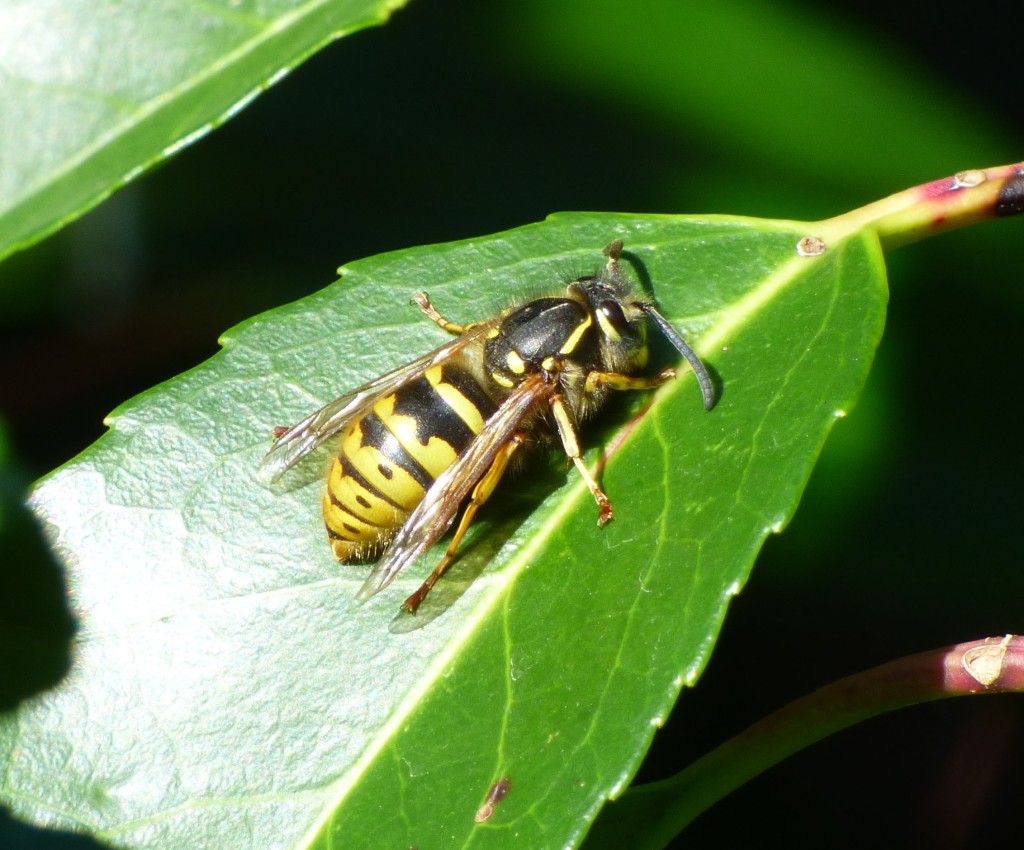
CONTENT WARNING: Contains lots of wasps, but if you’re frightened please read on. Also there is a video of a wasp fighting a spider later on.
Introduction
I am incredibly sorry. I did not know.
I assumed knowledge, and thus tolerance, that did not exist. As a result I was silent and complicit in an atmosphere of persecution. I should have spoken up. I did not. For that I apologise.
I have been attempting to fight prejudice and injustice, not only intraspecifically (within the human community) but interspecifically (across species boundaries) since I was around 18 years old. I have ever been a champion of patience, knowledge and understanding, even where gaining that knowledge required permitting temporary discomfort, so that we can arrive at better solutions to the problems we face in the world.
However there is one group for whom I have not spoken up as loudly as I could, if I have spoken up at all. That group is our wasps.
You might be thinking this is an inappropriately sombre tone, some kind of satire. You might think I am mocking genuine human rights campaigns around the world but, I’m not. This is not a joke and I am deadly serious. If you read on you will find out why, and I highly urge you to read on.
You should read on especially if you dislike wasps.

I promise I will do my best to refrain from judgement, I will try my hardest to think of people who hate wasps in an understanding and compassionate light. It would be foolish of me to do otherwise because you are many, and those of us who defend wasps are few. Something has clearly gone wrong, and an aggressive campaign to change hearts and minds is only going to see all wasp allies drowned out in a cacophony, a chorus, of negative replies.
So please, I am trying to be understanding and open-minded to you. Please, do me the same honour.
Why do we hate wasps?
When I first began compiling a list of the top ten hated, but misunderstood, animals in the world I knew I had to put the wasp on the list. I initially wanted to place it at number 9. This was my first big error.
I had dramatically underestimated the way people considered wasps. Rats were going to my original number 1 and, I will admit, they come close. The thing with rats is people are disgusted by them. The people who don’t like rats have a genuine feeling about them. I think it’s misguided, I think it’s ill-informed and, personally, I think they’re wrong. But at least they feel something.
With wasps, they are – whatever the animal equivalent of dehumanised is? – It’s like they don’t exist. It’s not contempt or disdain, again that’s a feeling that requires acknowledgement, acceptance of its existence. With wasps, the people who dislike them, it’s like they’d rather they didn’t exist at all.
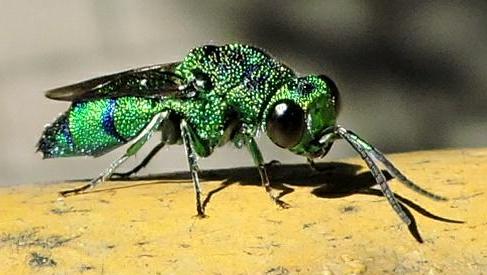
Where they do interact with those people the feelings associated with them are those of annoyance, of nuisance, of inconvenience. Again, a rat in your kitchen is an event! You will feel a bump of adrenaline, you’ll probably run at it to try and scare it, you will acknowledge it.
With wasps I see two reactions, dismissive hand-swatting, or defeated walking/running away. With a rat, its presence offends you. It is an intruder.
With a wasp, its existence offends you.
I knew none of this prior to the writing of this series of articles.
I was also planning on mainly focussing on the common wasp (Vespula vulgaris). This is the species most commonly known here in the UK and in much of Europe, although the UK is home to an estimated 9,000 wasp species. But you see the problem goes deeper than that. When I say “Wasp” I know exactly what you think and yet 99% of wasp species are not that.
By focussing on only one species in the Vespidae, I would be further contributing to a problem which is the lumping in of an estimated 75,000-100,000 different wasp species (or more!) with approximately 67 that are the ones we are prone to disliking.
Again, do not mistake this for some kind of satire. This is waspism – a systemic oppression of a large and diverse group of species based upon prejudices built by a very small minority and, even that reputation is founded largely on myth, fear and prejudice rather than any actual evidence.

I have been a campaigner for equality for many years so believe me when I say I am not taking this lightly. This is not a joke. One of the tactics utilised in dehumanisation when systemically oppressing people is to refer to them as particularly disliked species, as cockroaches, as rats. These systems – misunderstood disregard for wildlife and dehumanisation of people – actually tie in together. A disregard for an organism can become an identity you can give to another organism you don’t like, even if that organism is your kin. What if we remove that tool of dehumanisation?
I’ve mentioned in the various entries in this list my increasingly delving into the depths of the psychological, sociological and anthropological nature of our hatreds for certain animals and the mechanisms work very much the same as those we use to ‘other’ groups of people. They are born of the same cognitive mechanics, the same means of forming prejudices and biases, from the same feelings of distance, ignorance of value and, sadly, the same motivation for our own success and profit.
Take, for example, the rat from the last article. As far as public health initiatives go I could find little evidence that any significant effort has been made by governments in European nations or in the United States (either federally or state-specific) to promote awareness of rat-borne disease. Yet ‘disease’ and ‘dirty’ are probably two of the words people would most associate with rats. Many photos, articles, even academic papers I looked up talked of how “rats are a major carrier of disease.” Yet I could find almost zero evidence of significant, consistent, direct rat-to-human transmission of disease. Incidents do occur, mainly related to contamination of liquids (e.g. water, and in one case an outbreak of a disease in a school caused by contaminated milk) but in most cases it is very apparently a failure of human hygiene more than it is of rats being ‘unclean’.

There is very little evidence, certainly in the UK, of zoonotic disease transmission from rats to humans yet it is still part of their mythos, part of the stories we all tell each other about rats. It’s also very profitable. Extermination companies make a lot of money off of the idea that rats spread diseases and, I mentioned the ludicrous marketing on the website of extermination company Rentokil, incidentally a publically traded company on the FTSE 100 and their revenue for 2020 was over £2.8bn.
Yeah, that bank balance makes it clear why they want to perpetuate negative ideas about certain ‘pest’ species. Wasps are one such ‘pest’.
Take, for example, this story from 2019 in The Guardian, discussing a spell of hot weather in the UK that led to a 10% rise in sales for Rentokil. Who on their website, by the way, say wasps “can be life-threateneing [sic].” I’m not usually one to nitpick typos but, come on, £2.8bn a year and you can’t afford an editor?
Anyway they are ‘grateful’ to rats and wasps for this boost in revenue. Rats and wasps that likely would have been killed by their products or services to create that boost in revenue.
Journalist Rob Davies describes this increase as a ‘plague of wasps’. There is talk of flying ants that ‘wrought havoc at Wimbledon’ because, God forbid tennis should be interrupted by anything as trivial as life. It is described as a ‘pest plague’. Journalist Rob Davies is a business correspondent and, therefore, not exactly qualified to describe the complex and chaotic mechanics of the effects of extended periods of warm weather on the ecosystems of Great Britain with objectivity.
This heatwave brought in £1.6bn worth of income to Rentokil. Death pays.

But here’s the thing. Those wasps nests, that high numbers of wasps. It was for a reason. The conditions were perfect for a high number of wasps to exist. To explain why I am going to give you some details on the common wasp (Vespula vulgaris).
The Common Wasp Life Cycle
Around about April time wasp queens that have been dormant throughout the winter, hiding in wood, crevices, holes in the ground, sometimes gaps in the eaves of your house or even in the footprint of the old nest where they were born if it’s appropriate, become active.
During this phase they are solitary, queens will be flying around seeking a suitable nest site, and the provisions required to establish that nest. They will need to make sure they have access to food, for themselves the time of year is high in flowers and their nectar is the primary source of food for wasp queens. They also need to source food for their young which would mainly consist of invertebrates. They are also going to be busy looking for wood. The wood is what they will use to create their nest. They chew wood fibres in their jaws, mix it with a little bit of wasp spit, it creates a pulp and then the queen will build this into a few cells to lay eggs in to create the first workers. Wasp nests are made of this wasp-paper.
The queen will go off to find food for the larvae, the baby wasps, and will continue to maintain this small nest herself until the workers hatch. All of these wasps will be female.
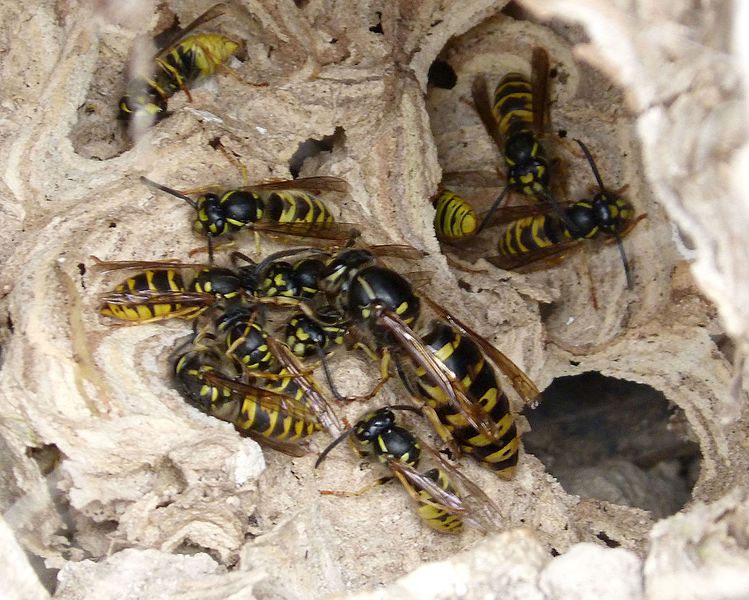
The hatching of the workers is the signal to kick up production. Those workers will now go out and find resources, more wood to pulp to increase the nest size and food to feed the new babies. At some point around this time the queen will cease her own foraging activities and will get into full time egg production. The workers will be in charge of building new cells and ensuring any laid eggs are grown into well-fed larvae, to become new workers, to keep building cells to keep growing. This process lasts a couple of months of producing workers and growing the nest.
At this point let me explain why Rentokil’s bumper profits in the summer of 2019 might not be such a great thing. Have you ever noticed how early summer wasps are more interested in your ham sandwich rather than your jam sandwich?
That’s because their larvae are actually fed a very high protein diet. Foraging wasps at that time of year are generally seeking that protein. Leave a chicken carcass out near a wasp nest in late May or June time and marvel – get a real close view of these wasps chowing down on that chicken.
They’re not eating it, though.
Instead they store it ready to regurgitate it to the larvae. Their larvae then process certain parts of the protein (particularly chitin from insect prey exoskeletons) and convert it into a sugary liquid that the adult wasps can eat. Other sources of sugary food at this time tend to be flower nectars and honeydew from aphids.

Now I mentioned leaving out a chicken carcass but animal proteins are not a wasp’s preferred choice. They’re hunters, predators, and excellent ones at that. They take down flies, aphids, caterpillars, maggots, grubs, mosquitoes, midges – I mean if it’s small enough or available enough they’ll chew it up and feed it to their young.
So these ‘pest’ wasps, during an average year, will probably, per nest, take out several tons of other invertebrates.
So of course Rentokil want to encourage you to ‘manage’ and ‘control’ (both words mean kill…just be upfront, guys) wasps. They’re not ‘pests’ they’re the damn competition!
These services of wasps as predators alone probably save billions of pounds per year on pesticides for commercial crops and wasps are pollinators too. The continued success of our flowering plants partially depends on wasps and all the other pollinators.
We’ve discussed ecosystem services in a lot of these articles. It’s the horribly brass-tacks way of defining the value of a living organism by demonstrating how much monetary value its existence provides to humans. I think it is a grotesque measure but in a capitalist society it is one hell of an effective communication tool.
For example a 2020 study gives a low estimate value of the ecosystem services of pollinators of $195bn worldwide, per year, or approximately 1.1 Elon Musks per year. I know which one I would prefer out of flowers, fruits, nuts and seeds and just over one Elons. One Elon is one Elon too many! But again, that’s the low estimate. Due to how complex and difficult to value these systems are the real value could be in the region of $200-600bn per year of pollinator value to humanity. Ten times the annual revenue of a Rentokil, who kill the pollinators!
The thing is, bees are very famous pollinators but they’re not the only ones. Butterflies, moths, hoverflies, other flies and our good friends the wasps, all provide pollination services, among other creatures. What’s more they don’t all pollinate the same flowers. So adding more honey bees to the environment won’t necessarily save us from the on-going pollination crisis! Persecuting wasps and flies is likely causing significantly more harm than you could possibly imagine.
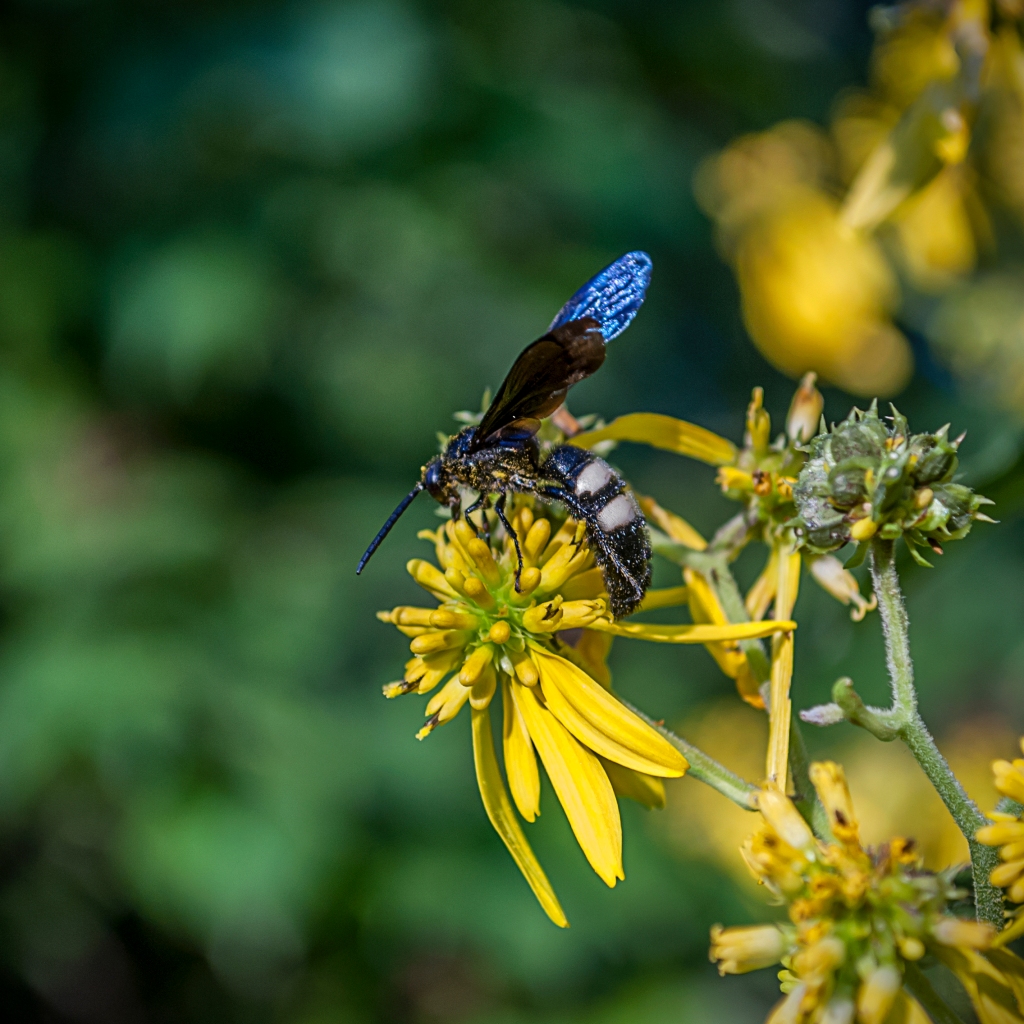
But hey! It’s keeping Rentokil’s bottom lines steady, so it doesn’t matter if in a couple of decades time the estimate 3-8% of agricultural crops wholly dependent on animal pollinators all just…POOF!…Vanish, does it?
Let’s get back to the life cycle of the common wasp. The part where I explain why wasps are actually useful in your environment is over. Now is where I make you feel guilty for hating late-summer wasps.
So their nests build up and build up until they reach their peak. At this point the queen will stop producing workers and will lay a small number of future queens and males. The workers will be at their foraging peak.
But then the decline starts. Without the need for so many workers, fewer eggs are laid and there are fewer larvae to feed. So the workers, who once mainly depended on their baby sisters for their sweet, sugary goodness, now have to look elsewhere. But it’s also the height of summer, dry grass, flowers turned to fruiting bodies. Those that can’t find sugary stuff from honeydew or whatever nectar is about will seek out your can of coke, or your slice of cake at the picnic.

Then the future queens and males are born. They mate, the existing queen gets sick or dies, the future queens disappear to get ready for their over-winter stay in whatever safe burrow they can find and what happens to all those workers?
Total social breakdown is what happens. All of the primary signals, all of the direction, usually provided by the queen, is now gone. Wasp society breaks down. Cannibalism occurs, the wasps who choose not to engage in this mutually assured destruction of sibling-munching free-for-all disappear, travelling alone hunting whatever sugary solace they can find.
It’s late summer now. Many of them find fruit, they like decaying fruit, fermenting fruit, it is more liquid, easier to eat but also basically gets them drunk and belligerent. Then they find your jam sandwich and notice it’s much better of a sugar yield so they go for that instead.
What do you do?
You flap your hands at this wasp whose entire social structure has broken down before its very eyes, whose entire world and being has collapsed into a void of uncertainty, everything that once drove and motivated it is now reduced to nothing but a drive to find sugar and live, live just one more day, but it can’t live without sugar and the sugars it could find came with lovely, delicious ethanol compounds. So this wasp, already lost and confused, now drunk, doesn’t care if there isn’t a hive there any more, it doesn’t care if there’s nothing to defend, you’re swinging your hand, you’re a threat, it will sting you.
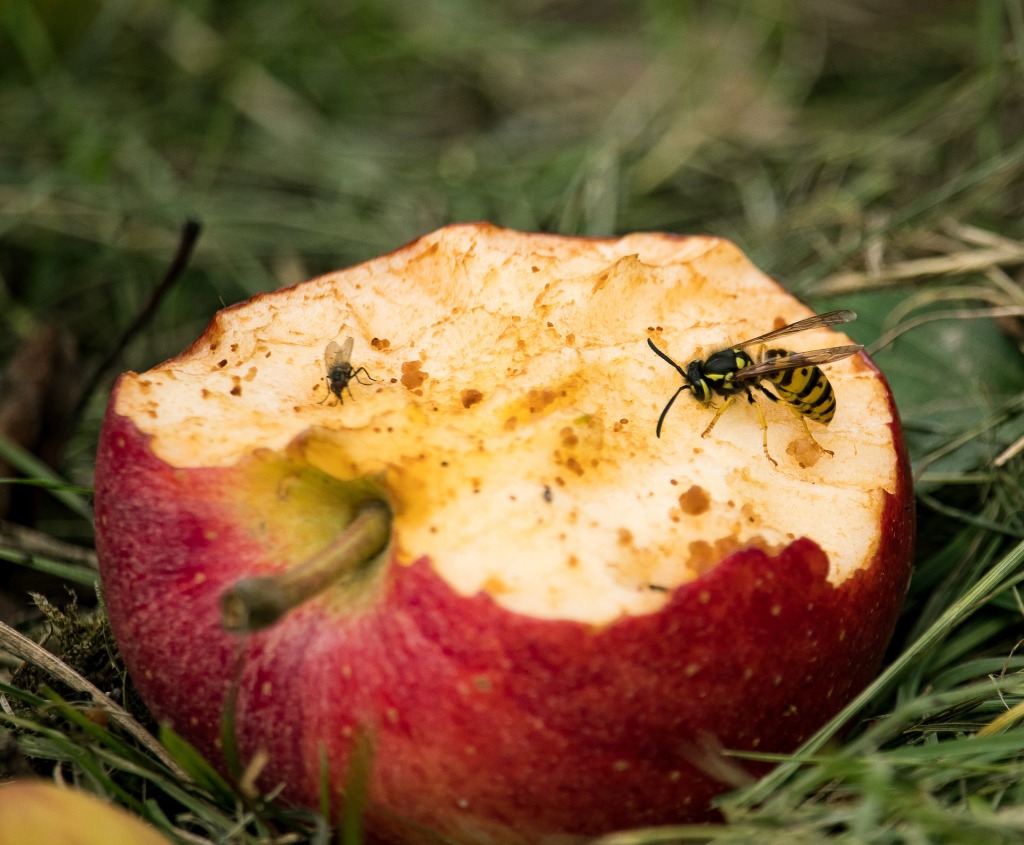
There’s a general ethic of ethology, the study of animal behaviour, not to anthropomorphise. That means we shouldn’t give human emotions or motivations to animal behaviour.
Two things – I’m not officially a biologist! I think anthropomorphising can be a very effective tool in driving empathy and understanding for a species. I think it is one of the things Sir David Attenborough did so well in his documentaries, managing to frame animal behaviours in a human-sympathetic and explicable way without making them too familiar, too human. It is not without its problems, but a proper cost-benefit analysis will probably find it does a lot more good than harm. That said I do believe we should move to a model where we can appreciate and understand wildlife without needing to relate it directly to humanesque lifestyles and traits.
The other thing, though, is the common wasp is a eusocial wasp. Whether it has thoughts and feelings is irrelevant. Whether it can consider the future is irrelevant. In the present it is wholly dependent upon a society to provide it with instruction, direction and place – When that society breaks down, when that society is removed, so is all sense of instruction, direction or place.
These wasps are literally lost and confused. There is no other way to consider it. To think that is anthropomorphising is to dramatically fail to see the importance of social structure on social animals. If we see a female meerkat get kicked out of her clan we don’t assume she’s all happy and light and meerkatting it up. We know she is now stressed, in mammals we can measure this, we have all sorts of hormonal proxies and surrogates we can use to test for stress, like levels of the hormone cortisol in the blood. Stress hormones have been found in other invertebrate species and I am fairly certain if one is not known already for wasps (I’ve only had a few days to put this piece together and crammed as much research as I could but I ran out of time) it will be found and it will be discovered late-summer wasps are full of it.
They’re stressed, tired, confused and literally dying. I don’t know if you know much of death in animals but rarely do they go gentle into that good night, and rarely is there any dignity in it. So what’s the difference between withering of starvation, getting splatted by a newspaper or getting drunk on partially fermented strawberry and drowning in a can of Fanta?
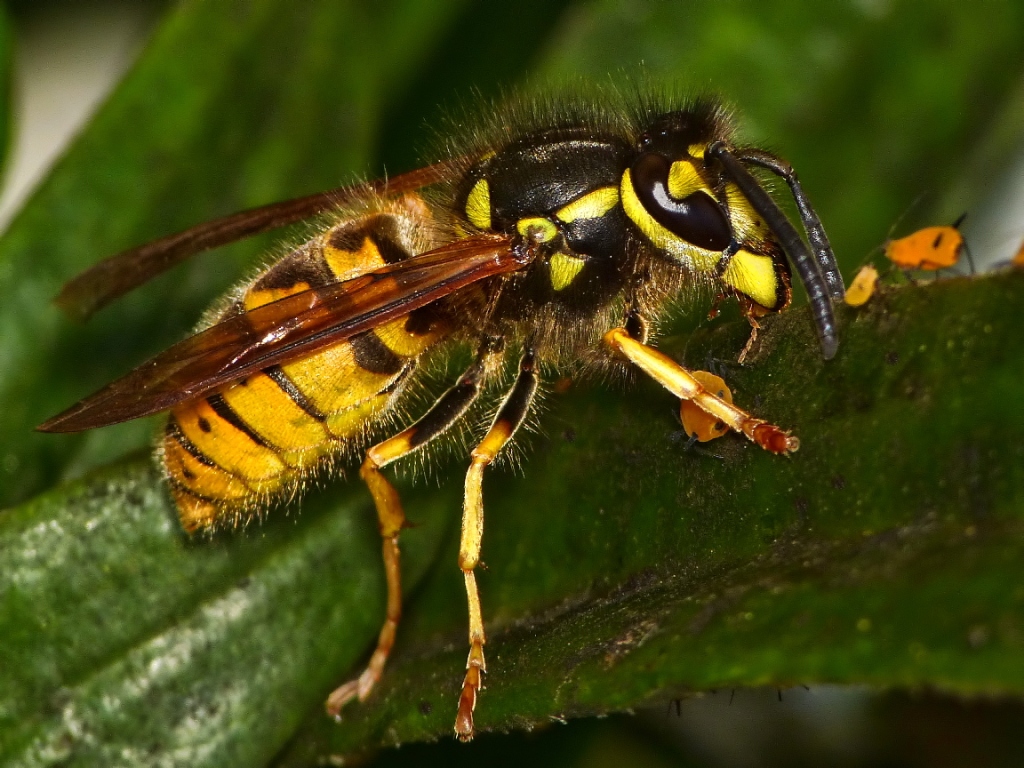
How Deadly Are Wasps?
At any other time than late-summer I can find no evidence that wasps are any more, or less, aggressive than bees. There is some evidence that wasp stings are considered more painful than bee stings. They also, as a matter of fact, kill more people than bees do.
However, these deaths are not caused directly by the wasp’s sting but by an allergic reaction, anaphylaxis, to the wasp venom. What is more, do you want to know the vast numbers we’re talking here? Between 2 and 9 deaths per year in the UK. Obviously harrowing for the people involved, and my deepest sympathies, but the average number of deaths for sports related accidents in the UK between the years 2006 and 2016 was 16 per year according to ONS statistics.
Sports is more dangerous than wasps.

In fact, in 2019 six people died of an infection by Listeria monocytogenes bacteria, known as listeria or listeriosis, from contaminated sandwiches or salads in UK hospitals.
Sandwiches and salads are, in any given year, potentially more lethal than wasps.
At what point Rentokil is going to make aggressively removing salads and sandwiches from shops by poisoning them a part of their business model remains to be seen, but clearly they are a pest and a public health menace.
Let me give you a few more things, based on Office of National Statistics data for 2009 that were more deadly than bee, wasp and hornet stings combined.
Bee, wasp or hornet stings: Total deaths 4
Eye diseases: Total deaths 5
Being hit by a train as a pedestrian: Total deaths 35
Falling on, or down stairs: Total deaths 644
Falling from a cliff: Total deaths 18
Being hit by an inanimate object (either falling or having been cast): Total deaths 39
Dog attack: Total deaths 5
Drowning in the bath: Total deaths 33
Accidentally suffocating in bed: Total deaths 11
Starvation: Total deaths 6
Herpes: Total deaths 23
Alcohol abuse: Total deaths 645.
But let’s abstract a little more. The deaths related to insect stings are almost exclusively caused by allergic reactions, therefore it is an underlying medical issue (allergy to wasp venom) and not necessarily the wasp that is to blame for the death.

Acute myocardial infarction (a heart attack) is caused when a decrease, or total stop, of blood flow to areas of the heart muscle causes those areas to be damaged or even undergo full tissue death (that’s what infarction means). Studies have shown that certain stressful events or situations can trigger an infarction in people already prone to the condition. For example a Dutch study in 1996 estimated an approximate 14 extra deaths of cardiovascular disease (infarction or stroke) correlated with an important football match, Netherlands versus France at Euro ’96.
There were 27,163 deaths from acute myocardial infarction in the United Kingdom in 2009. I bet you more than 4 of those were caused by outrage due to wildlife persecution. I’d bet good money on triple-figures being caused by sex or sexual arousal! Chances are more than 10 of those were related to shouting at politicians on the telly and do you see people calling for politicians to be culled?
…Actually…forget that last bit, yes you do.
Obviously I’m being a bit flippant. Wasp stings are venomous, can cause a nasty reaction and may require treatment but in most healthy people they are not a potentially lethal danger, in fact they are barely more than an inconvenience. In my life I have never knowingly suffered a bee, wasp or hornet sting, and I have spent time going out looking for bees, wasps, hornets and their nests!

Deaths from bee and wasp stings seem to only occur in people who have an allergic response to the venom. Globally they may also occur in people who have been stung sufficiently to be overwhelmed by the venom but this requires a remarkable amount of stinging and data suggests these common, eusocial wasps, your standard yellowjackets, have the most potent venom of all the wasps. Even then I believe it is approximately 20 stings per kg required to reach the lethal level of venom, meaning an average man (and deaths from wasp, bee and hornet stings disproportionately affect men, around 80% of global aculeate related deaths are men – So I’m not being sexist when I use a male model) weighing, say, 70kg would require 1,400 stings to die from the venom alone. It’s a lot, not impossible when you consider a swarm of hundreds of wasps and that they can use their sting repeatedly, but it’s still incredibly uncommon for someone to die of wasp stings exclusively with no allergic reaction involved.
So if they’re not killing people in droves I genuinely don’t understand why they are perceived as so dangerous. Beyond the fact that their stings hurt and we find it unpleasant there is no evidence they are a significant agent in human mortality.
Wasp Hate as Social Conformity
I highly suspect there is an aspect of aversive psychology going on in our dislike of wasps, but I also think it an unreasonable one, caused by us giving the wasp morality it cannot possess and agency it doesn’t have. When a wasp stings us, it hurts and we blame it. However I have caused myself significantly more pain and injury catching my toe on the castor on the base of my bed. I have not removed them, I have not hired a company to come around and dispose of them and I do not blame the castors or the bed. As noted above, there were 644 deaths from stair or step-related falls in 2009. I do not see building companies decrying elevating platforms and multistory buildings a ‘deadly’ and ‘dangerous’ ‘pest’! I don’t see bungalows springing up across the country.

I am also coming to realise how much of our understanding of nature is coded as social behaviour. It is culturally learned. I was speaking to my niece (7 years old) the other day about how I was researching and writing about wasps and she said “Oh I know wasps. The red ones are the deadliest.” I asked her what she meant and she said, “I don’t know.” I asked her how she knew the ‘red wasps’ are the deadliest and she said “I saw someone running away.”
Now to start with there is a red wasp, Vespula rufa, distinguishable by a slight reddy-brown tinge on their abdomen. They have smaller nests and they usually nest in earth, underground. They appear slightly later than their other common Vespulae buddies, with a shorter colony cycle usually ending around August in the UK.

However I can find no evidence that they are any more or less deadly than either Vespula vulgaris, the common wasp, or Vespula germanica, the German wasp, the other common yellowjacket wasp species in the UK.
So why does my niece think they are deadlier? Well she gives us the answer herself. She saw someone running away from a red wasp. This school friend presumably believed them to be deadlier than other wasps, possibly merely due to their difference in colour, or the fact that they are slightly less common to spot.
How pervasive is this across all people? How much of our behaviour towards wasps is not actually related to their relative levels of pain in their stings, not actually related to fear of an allergic reaction and not actually based in any significant knowledge of wasps, but based merely around a system of codified behaviours in human society that tell us to be cautious of wasps.
“They sting you!”
That’s a common refrain I hear when people say they don’t like wasps, but again – I’ve never been stung.
Ehrlich – a pest control company, owned by Rentokil, surprise surprise – Opens their ‘Real Truth about Wasp Stings’ page with “Nearly everyone has been stung by a wasp in their lifetime.” With zero damn data to back it up! In fact I can’t find any data recording actual figures of wasp stings or data of how many people have never been stung. There’s a project for some wasp scientists!
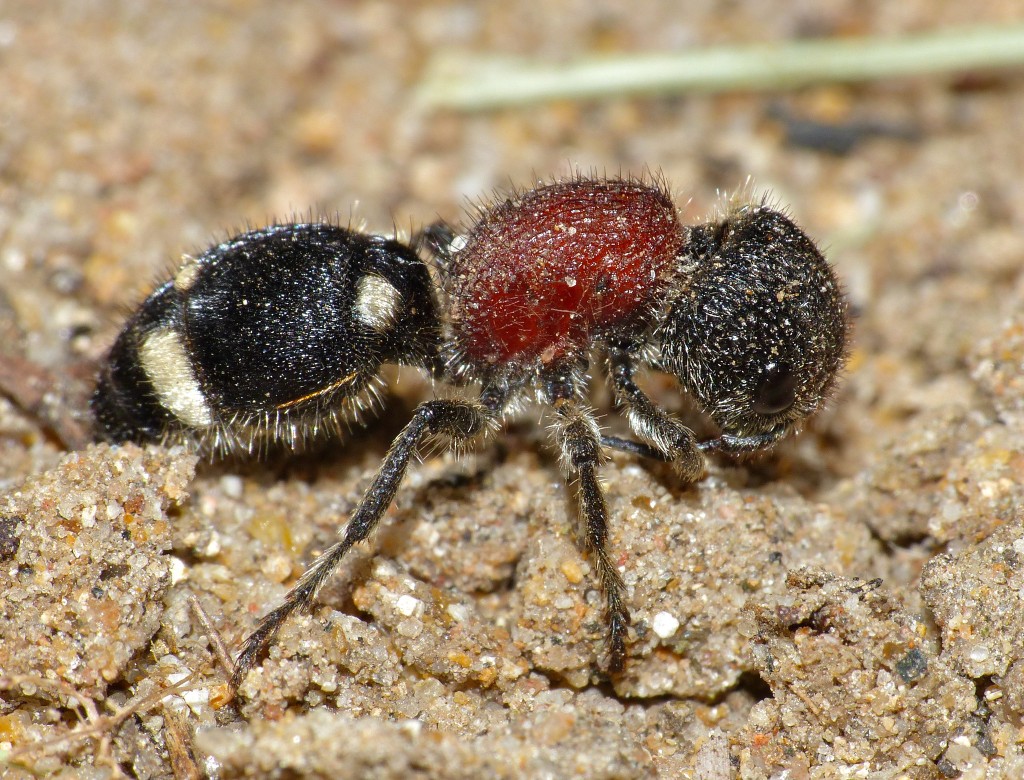
So we have no idea how many people are stung, no idea how many times in their lives people are likely to be stung and definitely no idea of other injuries to compare it to. Does the average, non-allergic, person have just as much chance of dying of an infected splinter as they do the number of average stings they receive in a lifetime? I don’t know, there’s no data I can find.
The point is I only know wasps are ‘bad’ because other people tell me they are. Now I have enough biological training (and I tell everyone the same thing, six months of undergrad biology is enough to give you a) a healthy respect for every living thing, b) a healthy suspicion of every living thing and c) panic attacks for the rest of your life) to not take this at face value. I like data, statistics and figuring out relative risks. Are most people basing their opinions more on social cues than actual evidence or interaction?
Here we drop back to the aye-aye article. The study by Randimbiharinirina et. al. in 2021 showed that people who had seen, or interacted with the aye-aye were less likely to believe in the local fady, the Malagasy taboo, that leads to the species’ persecution. People who owned or worked at plantations of sugar cane or cloves, where they are known to kill crop pests, were the most likely to hold a positive opinion. Knowledge of, closeness to, and interaction with species has a demonstrable effect on our consideration of them as positive or negative.
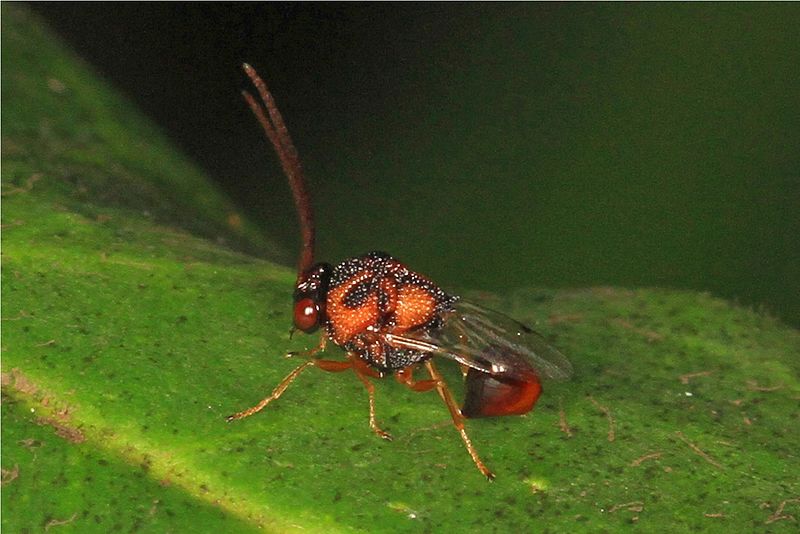
Meanwhile, adherence to social norms, with little desire to actually learn, study or understand an organism maintains a status quo of negativity.
This is why I opened this article as I did. I know it might seem crass at a time of huge social and human rights upheaval to put our opinion of wasps in the same categories as racism, colonialism or white supremacy but – it’s kind of the same mechanism and the resulting outcome is, undeniably, going to be the deaths of BIPOC, lower socio-economic status and Global South populations.
The Impact of Wasp Hate
You see wasps are a pollinator, pollinating species are seeing a shocking global decline, somewhere in the region of up to 75% reduction in populations in places. There is desperate, on-going ecology work to find the reasons for this, and counter it, because, as I have mentioned before, up to 8% of our global food crops require animal pollinators. As far as wild species go that number is probably significantly higher. So whilst humans are busy destroying habitats (particularly meadowlands, grasslands, areas usually abundant in wildflowers but that we prefer a nice, neat lawn on or are destroying for farming) we are also impacting the habitat of pollinators. When we reduce our numbers of pollinators it affects our food supply.
In the UK we already have record numbers of food-bank users. In 2009 (before the major impact of the financial crisis and the government campaign of cuts took its toll) there were already more deaths from starvation than bee, wasp or hornet stings! In 2017 the numbers of deaths where starvation or malnutrition was a mentioned factor in reported cause of death (according to ONS data) was 445 – the overall trend since 2003 has been rising. In the UK! A wealthy western nation, we are seeing increased death due to starvation! What is going to happen when our food supply is restricted due to lack of pollinators impacting the relative yields of food crops? More people starve. Globally! We’re probably talking millions or billions, of lives, a scale of death that makes Covid look like a damn birthday party in comparison!

All of this will, if current geopolitical and socio-economic trends continue, negatively impact black, brown, Asian, indigenous, low socio-economic status, disabled and Global South communities significantly more than it will rich white people. I’m a damn disabled working-class dude! My whiteness isn’t saving me in this crisis, I’m a dead man! And do you know what? You middle-class people need to watch your backs too, because this is going to bump you down that ladder. Persecution of pollinating insects, their rapid decline in numbers, and the impact it will have on our entire planet is going to be such a tsunami of suffering those waves will lap at your feet too! You’ll die too. You’ll go broke, lose your houses, lean on an uncaring government and learn the lessons people in my position have been trying to convince you of for years – this system is rigged and you’re disposable capital to them.
The persecution of wildlife and the persecution of people go hand-in-hand.
The only way out of this mess is through knowledge, respect, understanding and compassion. That means being amazed rather than horrified when you get stung by a lone wasp. I mean, if there’s a swarm get the hell out of there, but respect the swarm! If there is a nest severely impacting your quality of life, by all means take care of it. I don’t expect anyone to live with hundreds of wasps buzzing around their kitchen! But if it is in your yard, your garden, under your eaves and the greatest problem you have is the odd wasp bumbling in, find a way to co-exist with it.
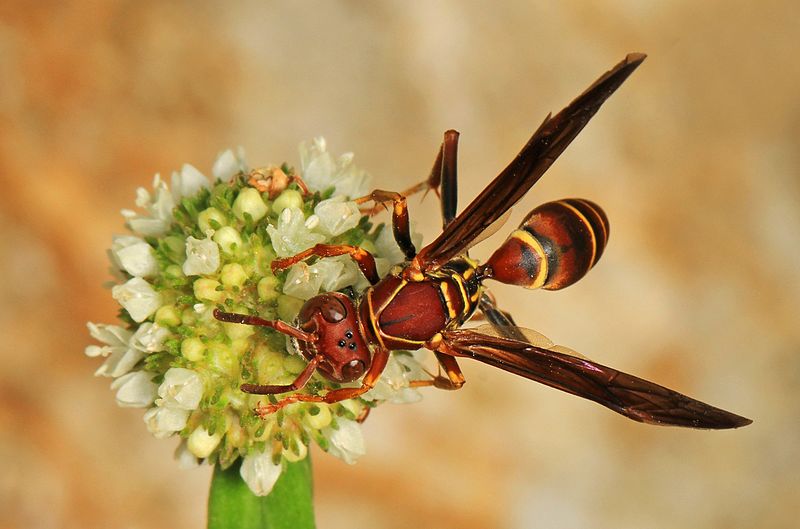
I once had a wasp nest near my house. I could see if in a tree not far from my house and it was a big nest. I had suspected there was one nearby because I’m a mucky pup who eats at his workstation and leaves things like food and food residues around (I’m not proud, don’t judge me) but wasps kept popping in, several a day, several times a day. Most of the time they found nothing of interest but for a period I had a chicken bone in a waste receptacle near my window and I kept seeing them come in, nibble on it and fly away. Remember, they feed protein to their young? Anyway I didn’t want wasps coming in hovering about my face where I work so I didn’t call exterminators, I didn’t call the local council, I didn’t throw rocks at the nest.
Instead I started leaving my chicken bones, and other protein-waste, further away from the main window-entrance on my external windowsill. I also softened a boiled sweet and left that out there. They rarely bothered me again. They stopped coming into my room, but I also got to watch wasps through the window, consuming either the sugary residue off the boiled sweet or grabbing the little remnants of chicken off the bone. Bees would visit the sweet, too! It took the experience from being a buzzing nuisance to being an excellent opportunity to observe these incredible creatures up close.

Now if you don’t want that experience, clean the hell up! Wasps scout, they go around looking for sources of food and when they find them they go back to the nest and tell their buddies and they will start coming regularly and in numbers! So clean the hell up! Keep sources of sugar and protein well secured, keep lids on your bins, don’t leave waste out in the open, don’t leave food out in the open and they will stop coming.
It’s not hard to manage wasps once you know their motivations, once you understand their lives.
Not All Wasps are Yellowjackets! Other Types of Wasp.
But I’m approaching 6,000 words deep and I have talked only of the Vespidae. Specifically only the Vespinae, the subfamily of eusocial aculeate (stinging) wasps (although I have placed many different examples in photos). This group accounts for less than 1% of all known wasp species, of which there are an estimated, worldwide, 100s of thousands or so. Numbers are hard, some of these wasps are tiny!
Sadly for ‘wasps’ they all get thrown into the yellowjacket bracket! It’s like with my shark list. One of the reasons I wanted to do that is because not only do I love sharks but people when they hear “Shark” immediately think of the white shark (or the Great White), they think of voracious predators, dumb, dead-eyed munchers of everything and I wanted to change that perception because sharks are varied in their lifestyles, intelligence, prey items and feeding behaviours.

This is like that but on a whole bigger scale. It’s like if I said “Plant” to you and all you could think of is a dandelion! Wasps are so diverse that for the word “wasp” to only be associated with less than 1% of their total representative species is…well it should be a crime of ignorance. Governments should go to prison for not shoving understanding of this diversity into the school curricula.
So let’s get off the topic of your vespines, yellowjackets, hornets and jaspers (some of the common names for the yellow-and-black wasps) and talk about some other wasps!
We will start with the largest genus in the Vespidae, Polistes. Also known as paper wasps (although other genera also build their nests out of paper) another common name for them is ‘umbrella wasps’ because they tend to build their paper nests in a fashion whereby they look a little like umbrellas. If you’ve ever seen a wasps nest that, from below, shows the open, cellular structure of the nest, this is probably made by a polistine wasp. Some of them, e.g. Polistes dominula, the European paper wasp, has the textbook black-and-yellow colouration. But there are over 300 recognised species in the genus Polistes and they represent the remarkable diversity of wasp species on their own.
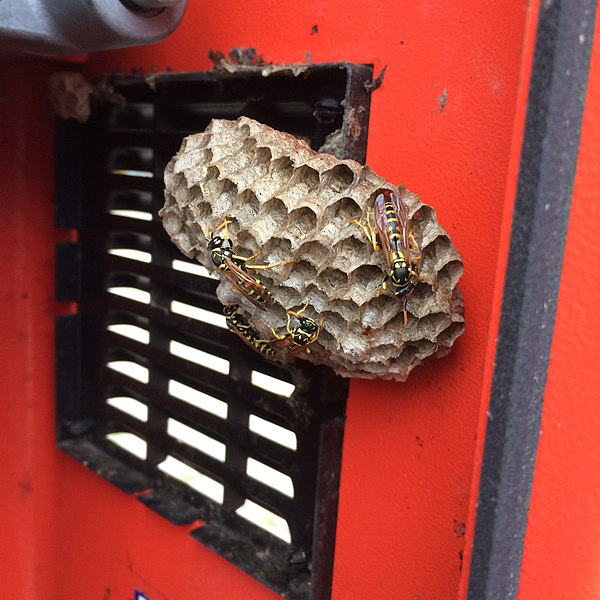
For example Polistes sulcifer is a polistine wasp who main reproductive strategy involves parasitising the nests of Polistes dominula! This is known as ‘brood parasitism’. Probably the most famous example of a brood parasite is the cuckoo, which lays its eggs in another bird’s nest, letting them do the raising of it.
The thing about it is the cuckoo is quite sneaky, shoving its eggs in the nest whilst the founders are away. Polistes sulcifer fights for its right to parasitise. It is strategic and systematic. It waits for the founding queen of the host nest to have laid worker eggs but prior to their emergence. This prevents it being outnumbered. Then it will fight the host queen, either evicting her or killing her. Then the parasite wasps disguises herself (unless you really want details about ‘cuticular hydrocarbon camouflage’ don’t worry about how and if you do, just google it!) so that she is considered just the regular old queen when the workers emerge. She is then free to lay her eggs and the unsuspecting Polistes dominula not only raise their own young but that of their parasite queen too!
If you don’t think that’s amazing I think you’re boring. Oh and you know how you all hate maggots? Well one of the common prey species of Polistes dominula (and therefore, for parasite reasons, of Polistes sulcifer) is fly maggots.
As for the disguise, well these hydrocarbon signatures are very important in some wasp species and are used to recognise related individuals. I have spoken in many articles about Hamilton’s rule. This is a biological theory of how species are more likely to perform altruistic or sacrificial behaviours for those more genetically related to them. It is defined simply by the formula rB>C where ‘r’ is the genetic relatedness, ‘B’ is the reproductive benefit gained by the altruism or sacrifice and ‘C’ is the reproductive cost to the individual performing the altruism or sacrifice. Well, W. D. Hamilton (an exceptional evolutionary biologist) used observations of Polistes wasps as one of his first inspirations for his kin selection theories.

Speaking of wasps and parasites, there is an entire family of parasitoid wasps. The difference between a parasite and a parasitoid is that a parasite generally lives on, or in, its host organism and often tries its best not to kill it unless that death is part of its life cycle in order for it to move on to parasitising another organism. A parasitoid has a close relationship with another species, often only utilising its hosts for a particular stage of life (usually the larval stage) and inevitably kills its host. That’s as simple as I can break it down, anyway!
There is a whole family of parasitoid wasps, the Ichneumon wasps or Ichneumonidae. These are some freaky bastards! Again they are numerous, Polistes is a genus, this is a family – so it is a taxonomic stage above the genus – and the Ichneumon wasps have many subfamilies, never mind genera! Excluding Antarctica they are found everywhere and they mostly use other invertebrates as their host.

THERE IS NO KNOWN HUMAN ICHNEUMON WASP! So don’t worry about you being parasitised by one of these amazing creatures. They are also mostly non-aggressive to humans and do not readily sting them unless specifically interfered with. Many of them are also solitary species so they do not build large nests or cause any damage to human habitations. Basically these guys, for however horrific you might find their lifestyle, are your friends. They probably take care of numerous of your garden pest invertebrates so, chill, don’t worry about them, they’re awesome.
There are two strategies for their reproductive behaviour. The first, known as ‘idiobiontism’ is where the host is paralysed, usually by a venomous sting, often taken to a burrow, hole or nest, where the egg is laid, hatches, the larva eats the host and grows into a beautiful wasp. The other strategy, slightly more horrific, is known as ‘koinobiontism’ and involves either temporarily stunning the host, or just chucking an egg right on or in it and letting it continue about its life as this parasite larva slowly starts to consume it from the inside out. As someone who is, what I would describe as a ‘Natural Decadent’ – that is to say I recognise the beauty in the suffering, decay and misery of nature – I think this is cool as hell!

Seney Natural History Association CC-BY-SA 2.0)
It’s a savage way to make a living, sure. When it was documented in the 19th century it inspired much thought about the notion of a kind, benevolent God. But why is it any crueler than just outright predatory behaviour? I think moralising any behaviour outside of our own is a pointless endeavour and trying to make sense of our own lives by observing and considering the behaviours of other species is a sure-fire way to either persecute another species or permit gross cruelties of our own. It’s stupid, don’t do it.
There are 25,000 described species of Ichneumons today and estimates of their total species numbers range from 60,000 to over 100,000. It means there is probably a wasp that parasitises every one of the pest species in your garden. Let’s all say the words together ‘ECOSYSTEM SERVICES!’ Ichneumon wasps probably save hundreds of millions of dollars-worth of crops every year, and reduce the need for pesticide use. They’re good for the environment so you want to keep them around. These are good wasps. Okay, they have some shady methods, but don’t question it when they help put food on your table.
Are you an arachnophobe? Do you hate spiders? Well not only is there a sub-family of Ichneumon wasps that parasitise spiders (the Pimplinae) but there is an entire family of spider-wasps! The Pompilidae. I can guarantee no matter who you are or what you’re into I can find you a wasp that’s your friend.
The Pompilidae behave similarly to Ichneumon wasps, they are parasitoid wasps.
I want to talk about possibly one of the coolest little groups of wasps on planet earth, the tarantula hawk wasps. They belong to two genera, Pepsis and Hemipepsis and as their name suggests they tend to parasitise large spiders, including tarantulas. The adult form, though, is a nectar feeder and is thus as innocuous to us as a hummingbird, unless you mess with it.
You see Pepsis grossa is one of the largest, if not the largest wasp in the world and it has an exceptionally large sting. Using the Schmidt pain index of insect stings (and we will talk about Schmidt later!) it is apparently the most painful sting of any wasp species, scoring a 4.0 on the scale. Only the bullet ant beats it for pain. The bullet ant is named after the pain of their sting, so think about that…

Regardless the sting of Pepsis grossa is, for being one of the longest, and most painful, incredibly non-toxic. This leads to the belief among wasp scientists that it is mainly used as a deterrent, a defence mechanism and they rarely sting unless they are being interfered with.
Pepsis grossa exclusively parasitise tarantula (the family Theraphosidae) in the Southern States of North America, through Central America and into South America. Their body size is somewhere between 3-5cm, with the females being larger than the males. Different colour morphs exist but they are mostly black and orange.
These things fight tarantula! I know! It’s crazy, they enter a tarantula’s burrow and incite the spider into a battle, drawing it out into the open where the wasp has the advantage of manoeuvrability, what it wants to do is draw the spider into its defensive posture, where it raises its two front legs. Once this is achieved the wasp gets right in there, its target is the second set of legs, because it wants to get its sting right at the nerve centre between the legs and the sternum. Boom! Paralysis! From here the wasp can drag the spider back into its burrow, or create another burrow of her own and lay her egg, just the one. She seals the burrow up, the egg hatches, feasts on the spider, grows into a beautiful and very large wasp and then gets out of the burrow and starts the process again.
An interesting thing is they tend to lay female eggs (unfertilised) on larger female spiders and male eggs (fertilised) on smaller, male spiders. I don’t know if they’re sexist, they might be! I highly suspect the size-difference is the big determining factor there, both the female wasp and female spider tend to be larger. It can be assumed a female wasp larva would need more food, then, so putting them on the larger specimens makes sense.

It’s an incredible species and there are Pompilidae who even only temporarily paralyse their host spider. Their young eat the spider alive from the inside out and specifically don’t target major organs to keep the spider alive as long as possible! Now that’s metal! Life is cruelty, but it’s such beautiful cruelty.
I’m only going to talk about one more group of wasps because, again, there are likely hundreds of thousands of species of wasp we could discuss, people could write books on them, and they have so if I have in any way piqued your interest do learn more about these beautiful, misunderstood and much maligned creatures. I’d be here forever if I tried.
So the last group of wasps I want to talk about is the fig wasps, put into the superfamily Chalcidoidae. As their name suggests these are wasps with a unique relationship with figs. In fact, these wasps lay their eggs in figs and their larval stage is spent inside figs. Many of them also act as pollinators for figs.
What is remarkable about fig wasps is they are what is known as a ‘polyphyletic’ group. That means it is a group made up of several unrelated lineages. Again we’ve discussed ‘convergent evolution’ before, when different organisms adapt a similar shape or lifestyle to fulfil a similar ecological niche. Well this would almost definitely qualify as that but it could also be what is known as ‘parallel evolution’, where organisms that already share similar characteristic independently evolve similar behaviours. Either way this relationship between the fig and the wasp is actually beautiful.

So for the typical life cycle of a fig-wasp (again, huge variation) let’s start with a fertilised female. She will travel down a small opening in the immature fruit of the fig tree (often pulling off her wings and antennae in the process). She will then lay her eggs and die. In pollinating wasps this is also when the pollen will be deposited. The figs grow and the wasps hatch and from there they grow together. The males will often hatch first, and their first act is to mate with the females before they, themselves, hatch. The males then dig their way out of the fig and usually die shortly after. This provides the females with a tunnel through which they can escape, already fertilised. Again in pollinating wasps the escaping females will pick up pollen on their way out that they can use to pollinate another fig tree but, once they emerge they start the process again.
It’s a remarkable relationship, an example of ‘coevolution’ – species developing together, and definitely more of a biological mystery than the chicken-and-egg dilemma. Which came first, the pollinator or the pollinated? The fig or the fig wasp?
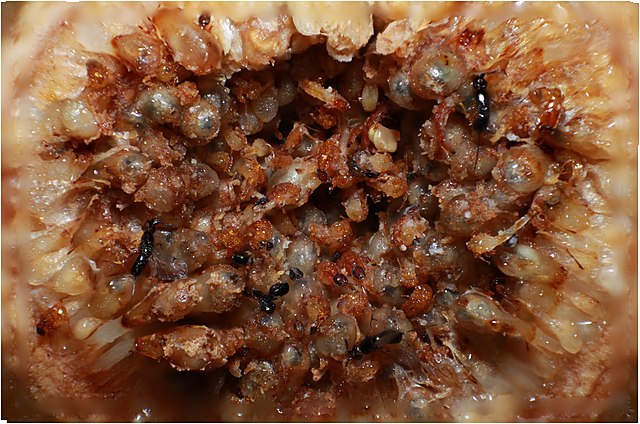
The relationship of fig and wasp is estimated to be 70-90 million years old, originating during the Cretaceous period. This is a relationship that out-survived the dinosaurs and has probably led to huge changes in fig and wasp species over that time period, as the species mutually evolve. It is another example of the complex weave, this clockwork tapestry of evolution that can surprise us at every turn. Nothing exists, or can exist, in a vacuum. Life needs life.
How Can We Help?
As we massacre species in this anthropocene extinction, reducing the biodiversity of our planet and maligning beautiful, complex, predatory pollinators as little more than ‘pests’ because they disrupt our picnics and barbeques we would do well to remember those three words. Life needs life.
The more harm we do to our natural world the more harm we do to ourselves. Life is cruel, let the Ichneumon wasps be a testament to that, beautiful in her cruelty, nature truly is the most marvellous dom in the great BDSM experiment that is life, but life is cruel. It will march on without us. It would take a cataclysm of the highest magnitude to completely exterminate all life on this planet. Not to burst our egotistical bubble but I don’t think humans are strong enough, big enough or clever enough to do it. The cold, inhospitable and amoral universe has tried its hardest and even it has failed, over nearly 4 billion years, to stop life on planet earth.

We hate, we persecute, we outcompete, we blame the outcompeted, we’re selfish, we’re overconsumptive, but all we are doing is slowly, but surely, decreasing our own chances of survival. Extinction is inevitable. There have only ever been two demonstrable fates of any living organism. Either your line is annihilated, or you become an ancestor of a new species. I think there is great value in the faculties Homo sapiens possesses and I wish to see them represented in species in the future, in our descendants. I fear, though, that our greatest strength is also our greatest danger. We are, as far as we know, the only species clever enough to see the harm we are doing, whilst simultaneously being too stupid to actually bother to stop it – and we could stop it if we tried.
The mechanism of selfishness, of disregard, of greed, of not wanting to share our world, or hoarding wealth, privilege and advantage, the mechanisms by which we, so crudely and foolishly measure our success on an individual level are our failings socially and environmentally. The same neuro-cognitive nonsense that causes human-on-human conflict, persecution, death and destruction is the same as that which we use to destroy our natural world and the amazing species within it.

In the words of the late, great Tupac Shakur;
It’s time for us as a people to start makin’ some changes.
Let’s change the way we eat.
Let’s change the way we live;
and let’s change the way we treat each other.
You see, the old way wasn’t working so it’s on us to do
what we gotta do to survive.
We need to rethink our entire systems of being, and include non-human species in those considerations too.
And just so anyone who reads this who wants to think I’m some sandal-wearing, dreadlock-bearded, dope-smoking hippy, so they can disregard my opinion, can be stopped in their tracks; I’m a hard-living, tough, working-class, sobre, meat-eating, chunky, strong son-of-a-bitch. I’ve spoken of my admiration for life’s cruelty, and I genuinely admire it. I choose peace because it’s the sensible option, but I’m not afraid to fight.
I just think human beings have achieved the most when they have worked side-by-side, putting aside whatever differences they have, to work towards a common goal. All of humanity’s greatest victories and successes have come by this method and it is foolish to think otherwise. Even competition works this way, and therefore all competition can be, and indeed should be, friendly competition. Only selfishness, foolishness and arrogance makes it otherwise.
Wasps are one of our most valuable pollinators, an effective predator, particularly of crop pests, a vast and diverse group of animals, with an almost incalculable value to our ecosystems, they range from the fugly to the fabulously beautiful, they have lifestyles that range from the most passive and chill to the most violent and voracious, the majority of their species have little-to-no interaction with humans whatsoever, they do not interfere with us in any way and 99% of wasp species have no sting with which to harm humans at all. Yet according to a 2018 study by Seirian Sumner, Georgia Law and Alessandro Cini the two words most associated with wasps are ‘sting’ and ‘annoying’.
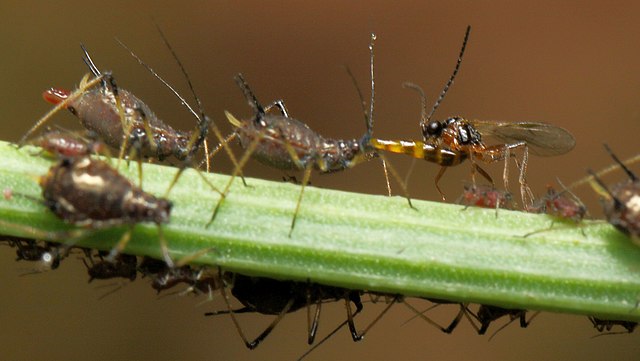
Oh this is not just aimed at laypersons. The life-sciences and the entire industry related to research and publishing research can hang its head in shame too. Academic research into wasps is grossly underfunded and papers regarding the eusocial wasps as pollinators and biological pest-control species were outnumbered by those about bees by a ratio of around 40:1.
The very communities that should be championing investigations into the importance of a diverse range of invertebrate species and the value that they hold, not only to us as humans but to the wider ecosystem, are failing species like wasps and it is for the same psycho-social reasons as everyone else. Wasps are culturally, and wrongly, unpopular. It is not ‘fashionable’ to research wasps, in attempting to obtain funding one will have to overcome the prejudice of the funding body to convince them wasps are worth studying. When it comes to getting papers published you’re going to have to convince a journal editor that your study is worthwhile and they will likely have prejudice against wasps. We need to change that. I do not use that word flippantly, the word ‘need’. Loss of biodiversity of invertebrates can and will kill a lot of people. We need to change how we think about these things.
#WASPLOVE – Thanks To the Community!

On the topic of that change the final thing I want to address in this incredibly lengthy article (it’s more of a non-fiction booklet!) is the wasp science community.
I studied biology, I did not graduate, I have no letters before or after my name, I’m no expert but my interest did not diminish when I dropped out of university for health reasons. I kept reading, I kept studying, I know my stuff and of the stuff I don’t know I know decent methods for researching it and a few things about how to tell good research from bad.
Yet whenever I try to interact with the biological communities online I always feel like the Prize Idiot! I know science is harsh, snobby and full of self-important people – it was one of the contributing factors in my dropping out. But there are a lot of people out there with an attitude liable to stifle curiosity, promote elitism and cause people to think all biologists are like that. I am a student of biology, I am one of you, and even I feel like an outsider. So if you recognise any of yourself in what I’m saying here, please stop it. Scientific literacy is vital to the future safety of our planet, our environment, our species diversity and us. Every single human being has a stake in this and you acting like the High Lord and Saviour of Knowledge is doing nobody any favours. The same goes for all the science community! If you don’t like interacting with idiots, stay the hell away from public forums.
But in researching for this article I contacted a couple of incredibly well known and highly regarded wasp scientists, specifically Seirian Sumner and Eric R. Eaton. Both of them were incredibly receptive to my enquiries, helpful, charming, Seirian introduced me to a whole host of wasp-enthusiast scientists and entomologists and Eric even followed me on Twitter for crying out loud!
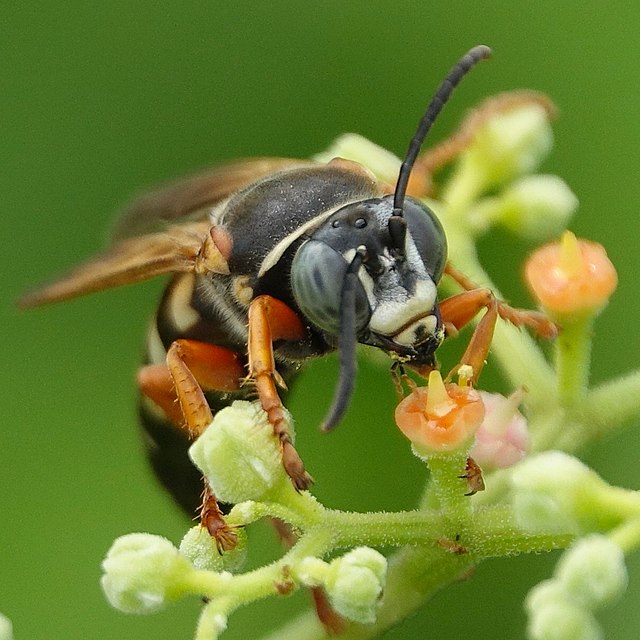
In researching this article I have found a huge amount of wasp related research papers are public access. In case you don’t know a lot of time academic papers are behind paywalls, access is restricted to institutions that pay an organisational fee or you can pay individually to access them. This, to me, is stupid! What’s more, as far as I’m aware, little-to-none of this money goes to the researchers, instead it is entirely subsumed by an obnoxiously greedy publishing industry that literally locks knowledge behind a door requiring a diamond-encrusted gold key to open it. Often, unless the journal itself is specifically open access, scientists and institutions have to pay to make their research open access! It is a ludicrous system. But, I’ve read so many wasp-related academic papers freely and openly.
It has been a long journey studying persecuted species and I think the wasp science community represents something unique about these groups of people. To care about something hated you already have to go against the grain, there’s a touch of rebel in so many of the scientists and organisations I have spoken about across this series. But, personally, it seems you also have to have a unique capacity for tolerance. You almost need a fearlessness in your tolerance.

Let’s talk about Schmidt for a second. Justin O. Schmidt is a nutter! I say that with the utmost respect. He is the entomologist (insect scientist) who came up with the Schmidt sting pain index for measuring the relative levels of painfulness of insect stings. The index is divided into 4 levels (1-4) with 1 being the least painful and 4 being the most. We looked at the Pepsis grossa earlier which has a Schmidt pain index score of 4, and discussed the bullet ant (Paraponera clavata) which I believe is one of very few species with a 4+ rating.
But you might be wondering how Schmidt got this data.
How do you think?
The potential for allergic reaction, plus the deliberate inflicting of potentially excruciating pain on experimental subjects means you could never get ethical approval to use human subjects. Using animal models would be inexact, different species experience pain differently and they can’t say “Ouch!” so you’d have to use surrogate measures to predict pain rather than just get a good idea. You have to use people. Pain is also incredibly subjective, so you can’t really use multiple people because they may all have a different idea of quite what’s more painful than what. Are you seeing where I am going?

Schmidt got the bulk of his data by being stung himself. He likely holds the record as the person who has been stung by the most different insects in human history. It is a record that is unlikely to be broken, because nobody else will ever be as stupidly clever as Dr. Schmidt.
I think there is something very special about scientists of persecuted, hated and misunderstood species and the wasp scientists, to me, represent the pinnacle. I am the wasp at their picnic. I flew in, buzzed around, started asking questions that to them would seem trivial or stupid and, instead of swatting me away they observed me, indulged me and welcomed me. I do not believe this is just chance or happenstance. I think it takes a special individual, an especially compassionate individual, to want to learn to love what is hated.
They represent everything We Lack Discipline stands for. A tolerance and acceptance of difference, a desire to find a way to cross barriers of socio-economic status, wealth, race, religion, class and nation to attempt to promote a knowledge and understanding over a prejudice and superstition. They represent patience in the face of ignorance, so long as that ignorance is not wilful. Let us be honest, they handle insects that cause untold pain, and Dr. Schmidt let himself get stung probably a thousand times or more “FOR SCIENCE!” and he’s not alone. This amazing paper by entemologist Dr. Emily A. Sadler et al. measuring the lengths (and ratio to body length) of wasp stings attempted to find a relationship between the size of sting and the pain of the sting. Mention is made of ‘personal observation’ of stinging events which I took as wasp scientists getting stung! so…They’re pretty much the definition of a Curious Idiot™! I have to respect that.

So to all of you in the wasp science community, to all of the scientific community I have interacted with across this entire series of articles on the top ten most hated, but misunderstood, species, I thank you.
Originally wasps were going to be my number 9. But in studying them deeper I realised they were so unjustly reviled. They became my number 1 but, more than that, they have become emblematic of human ignorance leading to persecution as a whole.
My voice is small, and I don’t expect it will lead to much at all – but, much as the bee has become a universal symbol of industriousness, I propose that the wasp become the universal symbol of the fight against ignorance, persecution and oppression in all its forms.
I think it fits, and I think wasps deserve it.

Catch up with the rest of the Hated (But Misunderstood) Animals top ten!
Top Ten Hated (But Misunderstood) Animals : Introduction
Top Ten Hated (But Misunderstood) Animals: Bats
Top Ten Hated (But Misunderstood) Animals: Pigeons
Top Ten Hated (But Misunderstood) Animals: Wolves
Top Ten Hated (But Misunderstood) Animals: Foxes
Top Ten Hated (But Misunderstood) Animals: Aye-Ayes
Top Ten Hated (But Misunderstood) Animals: Pika and Moles
Top Ten Hated (But Misunderstood) Animals: Vultures
Top Ten Hated (But Misunderstood) Animals: The European herring gull
Top Ten Hated (But Misunderstood) Animals: The Brown Rat
21 thoughts on “Top Ten Hated (But Misunderstood) Animals – 1 – Wasps”